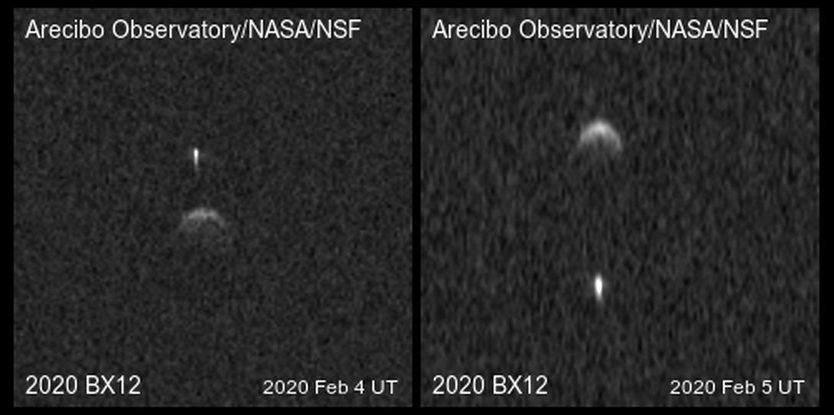Scientists just watched a newfound asteroid zoom by Earth. Then they saw its moon.
By Meghan Bartels - Space.com Senior Writer 4 days ago
One of Earth's premier instruments for studying nearby asteroids is back to work after being rattled by earthquakes, and its first new observations show that a newly discovered space rock is actually two separate asteroids.
The instrument is the planetary radar system at the Arecibo Observatory in Puerto Rico. The observatory was closed for most of January, after a series of earthquakes hit the island beginning on Dec. 28, 2019. The observatory reopened on Jan. 29. Meanwhile, on Jan. 27, scientists using a telescope on Mauna Loa in Hawaii spotted an asteroid that astronomers hadn't seen before. The team dubbed the newfound space rock 2020 BX12 based on a formula recognizing its discovery date.
Because of the size of 2020 BX12 and the way its orbit approaches that of Earth, it is designated a potentially hazardous asteroid. However, the space rock has already come as close to Earth as it will during this pass (2.7 million miles or 4.3 million kilometers); astronomers have calculated the asteroid's close approaches with Earth for the next century, and all will be at a greater distance than this one was.
Related: Photos: asteroids in deep space

Radar images show the binary asteroid 2020 BX12, which scientists discovered this year. (Image credit: Arecibo Observatory/NASA/NSF)
The asteroid's flyby wasn't a threat to life on Earth, but it was an opportunity for scientists who were hoping to learn more about space rocks. On Feb. 4 and 5, the radar station at Arecibo set its sights on 2020 BX12. Based on the observations, the scientists discovered that 2020 BX12 is a binary asteroid, with a smaller rock orbiting the larger rock. About 15% of larger asteroids turn out, on closer inspection, to be binary, according to NASA.
The larger rock is likely at least 540 feet (165 meters) across, and the smaller one is about 230 feet (70 m) wide, according to the observations gathered by Arecibo. When the instrument observed the two space rocks on Feb. 5, they appeared to be separated by about 1,200 feet (360 m).
Scientists couldn't gather enough data to be sure, but they suspect that the two rocks might complete an orbit of each other in 45 to 50 hours and that the smaller rock may be brighter than, and tidally locked with, its companion, meaning the same side always faces the larger object.
Existential dread is a key motivator for asteroid discoveries, and planetary defense experts hope that, by surveying nearby space rocks, they will identify a threat with enough time for us to protect ourselves. But asteroids are also scientifically interesting, since they represent rubble from the formation of the solar system.
No comments:
Post a Comment